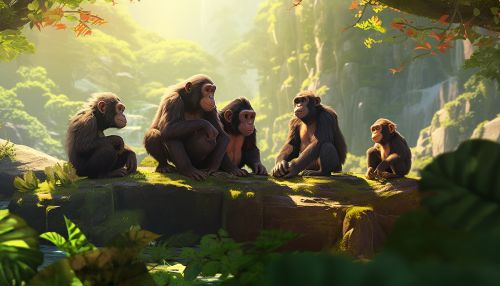The Evolution of Social Structures in Primates
Introduction
The evolutionary development of social structures in primates is a complex process that has been shaped by a variety of ecological and social factors. This article will delve into the intricacies of primate social structures, examining their origins, the various forms they take, and the evolutionary pressures that have shaped them.


Origins of Primate Social Structures
The origins of primate social structures can be traced back to the early Miocene epoch, approximately 20 million years ago. During this time, primates began to exhibit a shift towards more complex social structures, a trend that has continued to the present day. This shift is believed to have been driven by a combination of ecological pressures and the evolution of primate cognition.
Types of Primate Social Structures
Primate social structures can be broadly categorized into four main types: solitary, pair-living, multi-male/multi-female, and one-male/multi-female. Each of these social structures has distinct characteristics and evolutionary advantages.
Solitary
In solitary social structures, primates live and forage alone, coming together only for mating. This type of social structure is observed in several nocturnal primate species, such as the aye-aye and the slow loris.
Pair-living
Pair-living social structures, also known as monogamous social structures, involve a single male and a single female living together as a pair. This type of social structure is observed in a number of primate species, including gibbons and titi monkeys.
Multi-male/Multi-female
In multi-male/multi-female social structures, multiple males and females live together in a single group. This type of social structure is observed in several primate species, including chimpanzees and baboons.
One-male/Multi-female
One-male/multi-female social structures, also known as harem social structures, involve a single dominant male living with multiple females. This type of social structure is observed in several primate species, including gorillas and mandrills.
Evolutionary Pressures Shaping Primate Social Structures
The evolution of primate social structures has been shaped by a variety of pressures, including ecological factors, predation risk, and reproductive strategies.
Ecological Factors
Ecological factors, such as food availability and habitat type, have played a significant role in shaping primate social structures. For example, primates that live in environments with abundant, evenly distributed food resources tend to form larger social groups, while those that live in environments with scarce, patchily distributed food resources tend to form smaller social groups.
Predation Risk
Predation risk is another important factor that has shaped the evolution of primate social structures. Primates that live in environments with high predation risk tend to form larger social groups, as group living can provide protection against predators.
Reproductive Strategies
Reproductive strategies have also played a significant role in shaping primate social structures. For example, in species with high male-male competition for mates, males often form coalitions to increase their chances of reproductive success. This can lead to the formation of multi-male/multi-female social structures.
Conclusion
The evolution of social structures in primates is a complex process that has been shaped by a variety of ecological and social pressures. By examining the origins, types, and evolutionary pressures of primate social structures, we can gain a deeper understanding of primate behavior and evolution.
